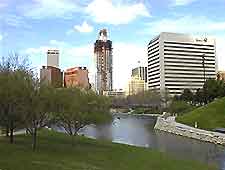Omaha History Facts and Timeline
(Omaha, Nebraska - NE, USA)

Omaha, meaning 'dwellers on the bluff', was originally home to Native Indians and largely a frontier town before Western expansion.
It came about in the 1800s as part of the Louisiana Purchase and was an early city of industry. The most noted aspect of history in Omaha was the huge tornado of 1975.
Council Bluffs
Council Bluffs (now
Iowa) was settled and named before Omaha, after explorers Lewis and Clark met with the Otoe tribe in 1804. It would be another half-century before the town itself was founded (on 4th July 1854) after the Kansas-Nebraska Act, although nearby
Lincoln was made state capital. Locals had a picnic on Capitol Hill, now Central High School, while the Mormon Pioneer Cemetery on State Street marks the spot where Mormons holed up in 1846 on their winter stop.
Vice and corruption came to Omaha early on, with illegal land speculators staking land. The later disbanded Omaha Claim Club's supported these speculators, with their vigilante law.
Frontier Town History
Omaha became an industrial hub in the 1860s, owing to its locale and the Western expansion of the railroads. Herndon House, on the corner of Farnam Street and 9th Street, held a ceremony for the railroad and later served as the Union Pacific Railroad's headquarters up until 1911. Although the building was demolished in 1922, the Union Pacific Museum still stands in Council Bluffs.
The Ak-Sar-Ben (Nebraska backwards and now Aksarben Village) civic organization was established in 1895. In addition, Jobbers Canyon (now gone), a close-knit area of buildings and red brick streets that looked like a canyon, was created, as was the historic Omaha Stockyards and several housing areas such as Sheelytown. The town thus garnered the moniker 'Magic City'.
There was much growth into the 1900s, when the Omaha University was founded in the year of 1908, along with the Scottish-Baronial-style Joslyn Castle in the Gold Coast district. The Stockyards were a big name in the world of meatpacking, while the Air Force moved to the Offutt Air Force Base. A major landmark from this time is the Rosenblatt Stadium, which was built in 1950 and stages the College World Series baseball tournament.
Civil Rights
Omaha was the scene of race riots in 1919 and was gripped during the Civil Rights movement, after suburbs in the 1950s became concentrated with blacks and ethnic minorities. Revitalized midtown and downtown areas have, in modern times, seen the divides of the past narrowed.
Omaha was hit badly in 1975 by an F4 tornado, which flattened hundreds of buildings and injured many people, while the Jobbers Canyon warehouses were razed for the Heartland of America Park in 1988, although the Old Market remains. Located on Howard Street, it features craft shops, cafés and popular restaurants. The Orpheum Theater, standing on South 16th Street, is another noted structure in Omaha history.
Omaha Today
Omaha today retains its entrepreneurial spirit and has erected many new skyscrapers since the turn of the millennium. They include the First National Center, which is the city's tallest building, constructed to replace the Woodmen Tower. The establishing of the CenturyLink Center in North Downtown was another significant event in local history.
 Omaha, meaning 'dwellers on the bluff', was originally home to Native Indians and largely a frontier town before Western expansion.
Omaha, meaning 'dwellers on the bluff', was originally home to Native Indians and largely a frontier town before Western expansion.